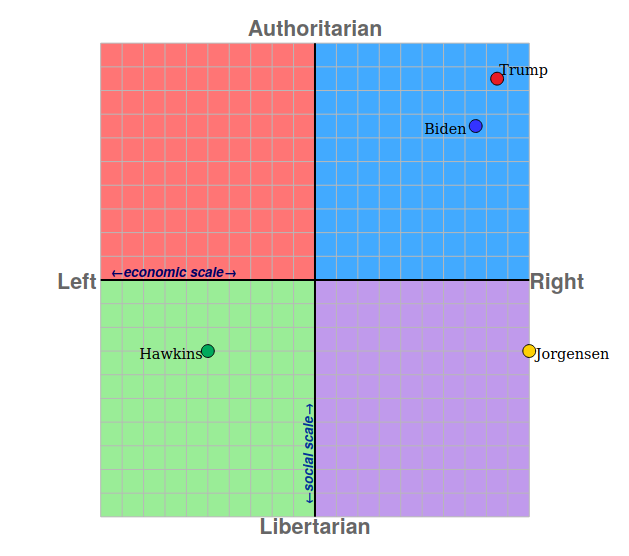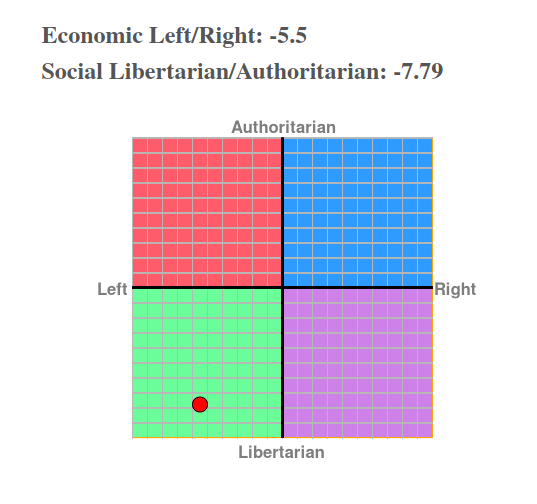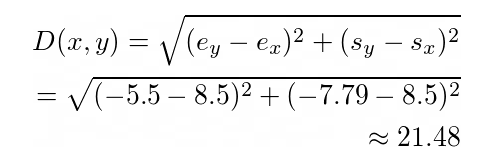Table of contents
Introduction
The 2020 election is coming up soon, so I figured that I would spit out my two pennies and tawk about who to vote for. It's the stable genius con man Donnie Trump squaring off against sleepy Joe Biden (and some other third-party candidates that have virtually no chance of winning). You're probably having a hard time working out who to vote for. Rather than discussing my silly opinion on who I think is the more qualified public servant, I figured that I'd dispense an interesting tool to help you decide who to vote for.
Political Distance
The first thing that you should do is clarify your political ideology. Politics can be hard to understand, mainly because you're dealing with abstract social constructs like human behavior in the aggregate, the economy, the government, and related social science concepts. However, there are tools that can help you clarify your thoughts, and one of those tools is the Political Compass.
The Political Compass is a tool that expresses an economic and social ideology in terms of a continuous, unilinear scale plotted onto a two-dimensional cartesian coordinate system. Have a look at figure 1 below:

Figure 1: The Political Compass for the four main candidates
Social scientists typically look at political phenomena from two dimensions: a social dimension and an economic dimension. The social dimension is about public policy that concerns the welfare of individuals (such as policy concerning race, compulsory education, et cetera) and the economic dimension concerns itself with how goods and services ought to be allocated, produced, and distributed.
The horizontal axis expresses the economic dimension in terms of left- and right-wing, where those closest to the "left" call for more government control of economic policy, and those closer to the "right" call for less government control of the economy. The vertical axis represents the social dimension, where those going upward are more authoritarian, and those going downward are more libertarian or anti-authoritarian.
Of course, this scale isn't perfect. The makers of the political compass admit that it isn't universal [1] and that it exists within the context of modern western nations. [2] No political compass test is perfect, but nonetheless, it can be helpful when clarifying our thoughts.
So "eyeballing" figure 1 gives us the following coordinates for each candidate:
Joe Biden: (8.5, 6.5)
Donald Trump: (8.5, 8.5)
Jo Jorgensen: (10, -3)
Howie Hawkins: (-6, -3)
My eyesight is lousy, but these are the (x, y) coordinates that I got from eyeballing the chart. Now, let's see where we land on the political compass.
First, go to the following link and fill out the quiz to the best of your ability: https://www.politicalcompass.org/test

Figure 2: My Political Compass results.
After you fill out the political compass test and click on the "now let’s see where you are" button, you should have a chart similar to the figure 2 chart above. In my case, I'm -5.5 on the economic axis and -7.79 on the social axis. Now here's where the real fun begins.
You can work out which presidential candidate is "closest" to your ideology with the Euclidean distance formula, which in this context I shall define as:

Here, "e_y" is your score on the economic dimension, "e_x" is the score of the economic dimension of the candidate that you're comparing yourself to, "s_y" is your score on the social dimension and "s_x" is the score of the social dimension of the candidate that you're comparing yourself to. Let's suppose that I wanted to compare myself to the Donald. I would then have:

Now, let's do Joe Biden, Jo Jorgenson, and Howie Hawkins (in that order):

So, the "distances" between myself and the candidates are 21.48 for Trump, 20.01 for Biden, 16.22 for Jorgenson, and 4.82 for Hawkins. The candidate who will implement policies that are "closest" to your ideology will be the candidate with the lowest number, and it's Howie Hawkins in my case.
However, you may want to consider the fact that third-party candidates are unlikely to win into your political calculus. In that case, Biden is "closest" to me in the context of the two-party dichotomy that has unfortunately been set up in the United States.
Final thoughts
Again, this method of "closest political distance" isn't perfect. It shouldn't be a substitute for rigorous research before election night. Be sure to watch news outlets that present from the perspective of all ends of the political spectrum. Listen to people with whom you agree, and more people with whom you disagree. Visit the presidential candidates’ websites and review their policies carefully.
Also, try to read up on academic research. News media, regardless of ideology, has a bad habit of oversimplifying facts. Peer-reviewed technical papers tend to be more rigorous and less biased when compared to news articles. Google Scholar, Microsoft Academic, JSTOR, Web of Science, and other bibliographic indices are your friend. Keep in mind that if you can't afford to buy academic articles (they can go up to $50/paper), there's always Sci-Hub ;-)
Now get out there and vote like you've never voted before!
Endnotes
Authors note: this is an unfinished draft of a political essay that I was hoping to publish to help voters select the best presidential candidate for America’s 2020 election. The method described in this article is fundamentally flawed because, as I have been reliably informed, the Political Compass is not a useful tool for describing one’s political ideology. I am just publishing this for archival purposes and I recommend that readers conduct their own independent research when voting.
![Who to vote for [Unfinished Draft]](https://cdn.hashnode.com/res/hashnode/image/upload/v1673433739324/2833cc3b-4cec-4441-8d7c-1393a9202f22.jpeg?w=1600&h=840&fit=crop&crop=entropy&auto=compress,format&format=webp)